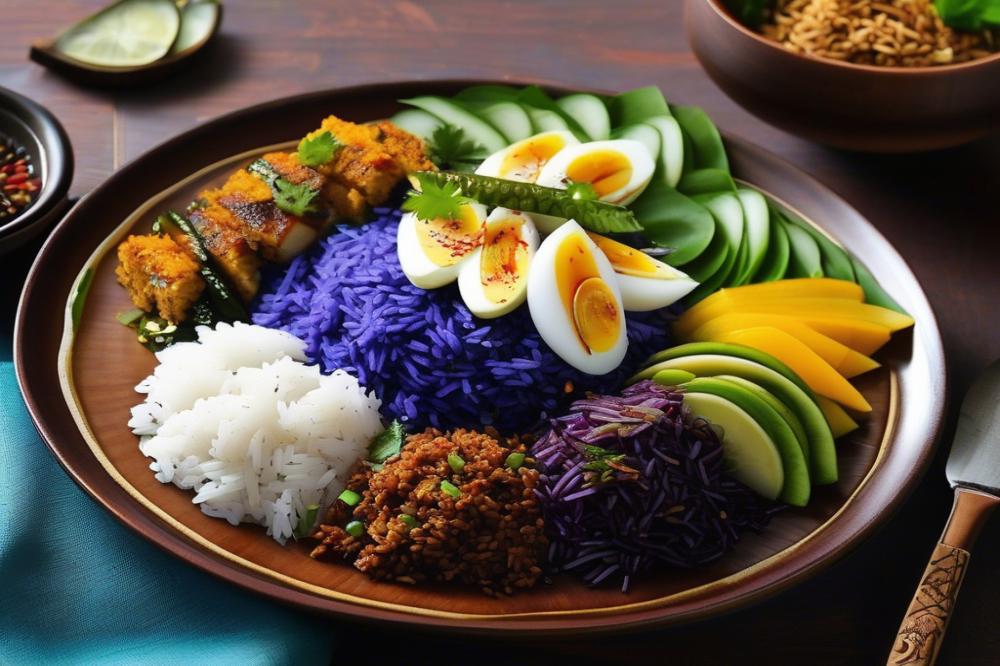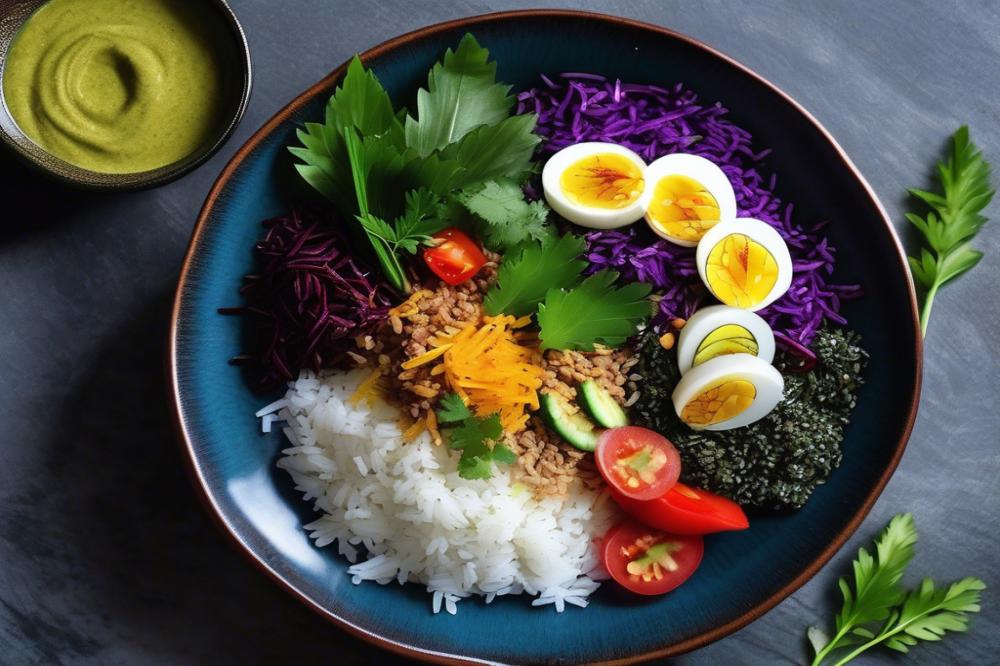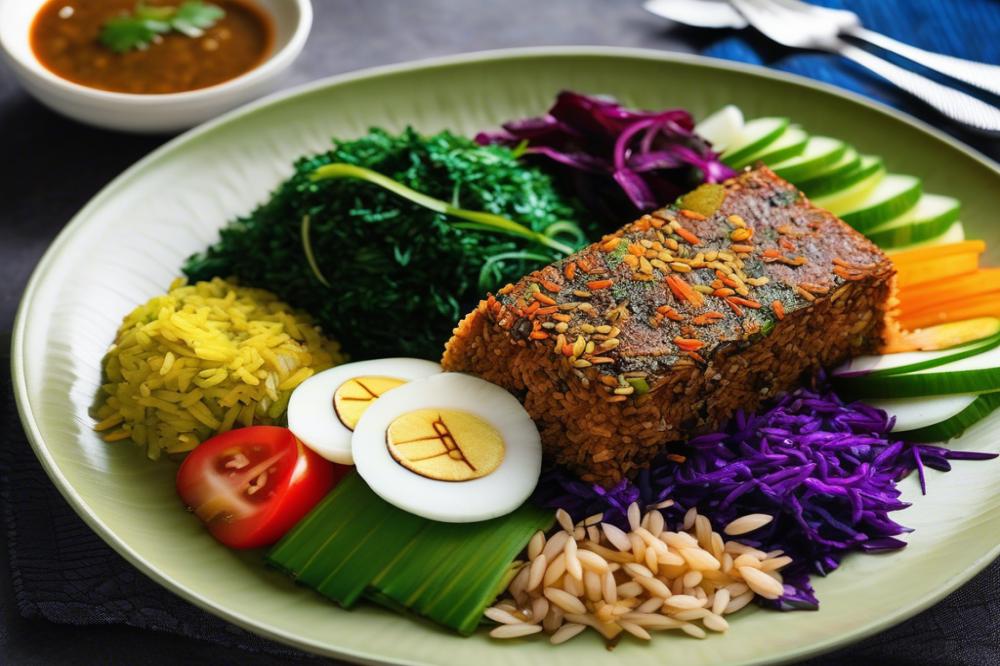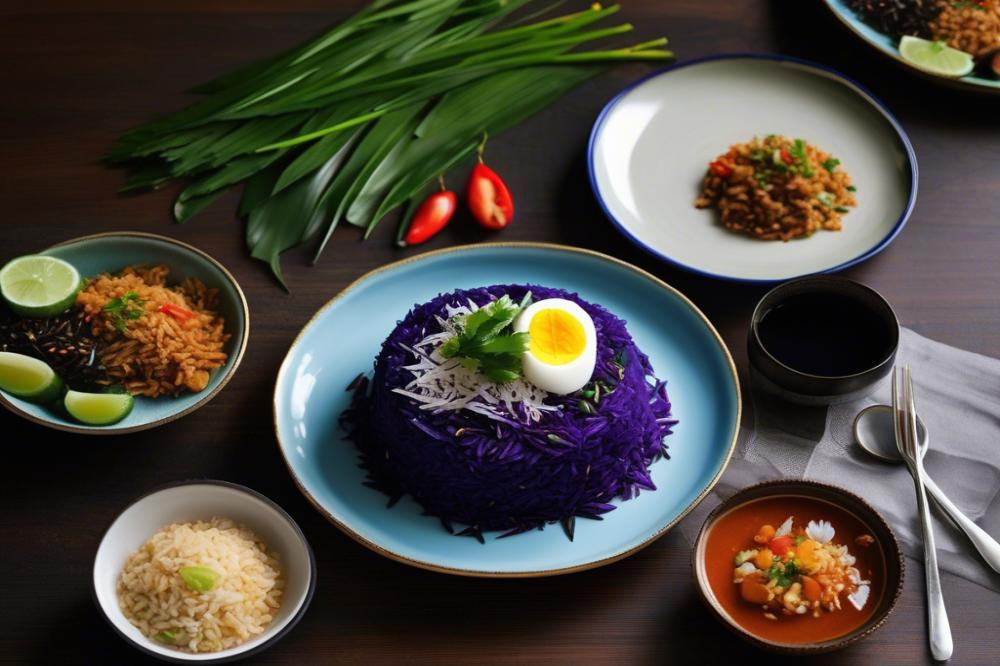Overview of Nasi Kerabu as a Beloved Malaysian Dish
Nasi Kerabu is a cherished rice dish from Malaysia, known for its vibrant blue rice and aromatic herbs. This traditional recipe reflects the rich cultural tapestry of the region. Often served with various garnishes, it offers a feast for the senses. As one takes in the colors and fragrances, the dish captivates both locals and visitors alike.
Historically, the roots of this delightful meal can be traced back to the East Coast of Peninsular Malaysia, particularly among the Kelantanese people. The use of blue rice, colored with butterfly pea flower, sets it apart from other rice dishes. Not only does it look beautiful, but it also carries stories of heritage and tradition, connecting people to their land.
In addition to its eye-catching appearance, qualities of Nasi Kerabu make it a healthy meal choice. The incorporation of coconut rice, turmeric, and flavorful spices enhances the taste while promoting wellness. A variety of aromatic herbs, such as mint and coriander, are often included to elevate the flavors and aromas of this cultural dish.
This dish is more than just food; it represents a connection to Malaysian cuisine and its essence. Preparing Nasi Kerabu involves a labor of love, often enjoyed at family gatherings and celebrations. Each bite tells a story, bringing together families and friends in a shared experience that honors the culinary art of the region.
What is Nasi Kerabu?

Nasi Kerabu is a vibrant rice dish that originates from Malaysia. It is known for its striking blue color, which comes from the natural dye of the butterfly pea flower. This colorful presentation is just one aspect of its charm. The dish is not only visually appealing but also packed with flavors from a variety of aromatic herbs and spices. Each serving is a feast for both the eyes and the palate.
Cultural relevance plays a significant role in understanding this traditional recipe. Nasi Kerabu is often associated with the Malay community, especially in the northeastern states of Kelantan and Terengganu. Variations exist across Malaysia, with each region adding its unique twist. For instance, some may include fried fish or grilled chicken as protein options, while others focus on different types of garnishes and spicy sambals.
The way Nasi Kerabu is served adds to its allure. It typically features a bed of coconut rice, flavored with turmeric and served alongside an array of side dishes. Common accompaniments include pickled vegetables, salted egg, and keropok, a type of crispy cracker. These add texture and enhance the overall experience of enjoying this healthy meal.
This cultural dish is more than just a meal. It reflects the diverse traditions and culinary practices found throughout Malaysia. Each bite tells a story of heritage and creativity, demonstrating the amazing world of Malaysian cuisine.
Ingredients and Cooking Instructions

List of Ingredients with Quantities:
- Blue Rice: 2 cups of white rice, 1 tablespoon of butterfly pea flower petals
- Coconut Milk: 1 cup
- Aromatic Herbs: 1 cup of finely chopped herbs (mint, basil, and torch ginger)
- Turmeric: 1 teaspoon
- Spices: 1 tablespoon of coriander powder and 1 teaspoon of cumin powder
- Garnishes: 1/2 cup of grated coconut, 1/4 cup of fried shallots, and slices of cucumber and lime
Nutritional Information Overview for Each Ingredient:
White rice provides carbohydrates and a small amount of protein. Butterfly pea flower petals add natural color and antioxidants. Coconut milk offers healthy fats and some vitamins. The aromatic herbs are rich in vitamins and minerals. Turmeric is known for its anti-inflammatory properties. Coriander powder and cumin powder contain compounds that may aid digestion. Garnishes like grated coconut and fried shallots add flavor and texture, while cucumber and lime offer hydration and vitamin C.
Step-by-Step Cooking Instructions:
Start by preparing the blue rice. Rinse the 2 cups of white rice under cold water until the water runs clear. This step removes excess starch and helps achieve a fluffier texture. Soak the rice in water for 30 minutes. While the rice is soaking, boil 2 cups of water. Add the butterfly pea flower petals to the water. Let it steep for about 10 minutes until the water turns a beautiful blue.
Next, strain the petals out of the water. Use this blue water to cook the rice. Add the soaked and drained rice to a pot with the blue water. Cook on medium heat until the water is absorbed, about 15-20 minutes. Once done, remove the pot from heat. Let the rice sit covered for another 10 minutes to finish steaming.
While waiting for the rice, prepare the coconut milk mixture. Heat the cup of coconut milk in a saucepan. Stir in 1 teaspoon of turmeric and mix until well combined. The turmeric not only adds flavor but also enhances the vibrant color of the dish.
Now it’s time to prepare the aromatic herbs. Chop mint, basil, and torch ginger finely. The mixture should total 1 cup. These herbs will provide freshness and a burst of flavor to the rice dish.
After everything is ready, it’s time to assemble. Fluff the blue rice with a fork. Drizzle the coconut milk mixture over the rice. Now, gently fold in the chopped aromatic herbs along with the flavorful spices, including 1 tablespoon of coriander powder and 1 teaspoon of cumin powder. This will ensure that every bite is packed with deliciousness.
Lastly, add the garnishes. Sprinkle 1/2 cup of grated coconut and 1/4 cup of fried shallots on top. These garnishes add crunch and richness. Serve the dish with fresh slices of cucumber and lime on the side. This unique cultural dish brings together many elements of Malaysian cuisine. Enjoy your healthy meal!
Flavor Profile and Health Benefits

Nasi Kerabu is a rice dish that stands out for its delightful combination of flavors. This Malaysian cuisine features aromatic herbs and flavorful spices that create a complex taste experience. Commonly included ingredients are lemongrass, ginger, and kaffir lime leaves. These spices contribute a fragrant aroma that fills the air. Turmeric gives the rice its signature blue hue and adds a mild earthiness to the dish.
Besides taste, it’s important to note the health benefits of these ingredients. Aromatic herbs like mint and cilantro not only boost flavor but also add essential vitamins. Mint is known for its refreshing properties and digestive benefits. Cilantro contributes antioxidants, which are vital for health. Eating a dish rich in fresh herbs can support overall well-being.
Furthermore, coconut rice provides a creamy texture that enhances the meal. The inclusion of coconut milk also adds healthy fats, which can keep you feeling full longer. Together, these elements create a nutritious meal option that can satisfy a variety of dietary needs.
In essence, Nasi Kerabu serves as a cultural dish that combines taste and nutrition. The combination of herbs, spices, and rice makes every bite enjoyable. This traditional recipe offers a plethora of nutrients, allowing it to fit into a healthy meal plan effortlessly. With its vibrant colors and rich flavors, this dish truly showcases the heart of Malaysian cuisine.
Serving Suggestions and Variations
Nasi Kerabu is often served with a variety of accompaniments. Fried fish or crispy fried chicken make excellent pairings. These proteins provide a crunchy contrast to the soft blue rice. For those who enjoy spiciness, sambal adds a fiery kick. This chili paste enhances the flavors of the dish in a delightful way.
Different regions of Malaysia have their own versions of this rice dish. In Kelantan, one might find a stronger emphasis on fresh vegetables and local herbs. Meanwhile, other states might offer unique garnishes or more elaborate side dishes. Some are even served with a side of coconut rice, adding an extra layer of creaminess and flavor.
Customization is a big part of enjoying this traditional recipe. Many people choose to add more aromatic herbs or different meats based on personal tastes. For instance, grilled chicken or prawns can be healthy alternatives. Vegetarians can replace proteins with tofu or extra vegetables. Adjusting the spices allows one to create a milder or hotter dish, appealing to anyone’s palate.
Whether for a family meal or a festive gathering, this cultural dish can be tailored to please everyone. Experimenting with various sides and toppings makes each plate exciting. The journey of creating your version can be just as enjoyable as the final dish. With many options available, everyone can savor the beauty of this Malaysian cuisine.
A Taste of Tradition
Nasi Kerabu holds a cherished place in Malaysian cuisine. This vibrant dish, with its striking blue rice, offers more than just a meal; it embodies the culture and traditions of the Malaysian people. Each component of the dish tells a story, from the fragrant herbs to the rich flavors. Enjoying this plate is like a journey through Malaysia itself.
Trying out this recipe at home can be a delightful experience. It allows you to connect with the culture in a personal way. As you gather the ingredients, you will discover the joy of preparing something that has been loved by many for generations. Cooking is not only about nourishment but also about sharing love and experiences with those around you.
Sharing Nasi Kerabu with family and friends can spark conversations about its history and significance. This traditional dish brings people together, creating a warm atmosphere filled with laughter and joy. Whether you are a seasoned cook or just starting, making this recipe can turn any meal into a special occasion. Taste the aromatic herbs and explore the flavors that define this beloved dish.
In the end, preparing and sharing this dish can remind you of how food connects us all. So gather your ingredients and invite your loved ones to partake in this cultural experience. Enjoy the process, savor every bite, and appreciate the traditions that come with it.



